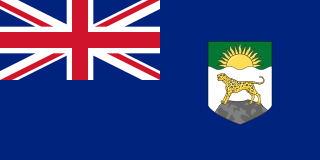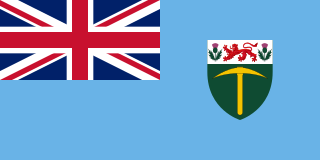
Nyasaland was a British protectorate in Africa that was established in 1907 when the former British Central Africa Protectorate changed its name. Between 1953 and 1963, Nyasaland was part of the Federation of Rhodesia and Nyasaland. After the Federation was dissolved, Nyasaland became independent from Britain on 6 July 1964 and was renamed Malawi.

Northern Rhodesia was a British protectorate in Southern Africa, now the independent country of Zambia. It was formed in 1911 by amalgamating the two earlier protectorates of Barotziland-North-Western Rhodesia and North-Eastern Rhodesia. It was initially administered, as were the two earlier protectorates, by the British South Africa Company (BSAC), a chartered company, on behalf of the British Government. From 1924, it was administered by the British Government as a protectorate, under similar conditions to other British-administered protectorates, and the special provisions required when it was administered by BSAC were terminated.

Southern Rhodesia was a landlocked, self-governing British Crown colony in Southern Africa, established in 1923 and consisting of British South Africa Company (BSAC) territories lying south of the Zambezi River. The region was informally known as South Zambesia until annexation by Britain, at the behest of Cecil Rhodes's British South Africa Company. The bounding territories were Bechuanaland (Botswana), Northern Rhodesia (Zambia), Portuguese Mozambique (Mozambique) and the Transvaal Republic.

Sir Roland "Roy" Welensky was a Northern Rhodesian politician and the second and last Prime Minister of the Federation of Rhodesia and Nyasaland.

Sir Charles Patrick John Coghlan,, was a lawyer and politician who served as Premier of Southern Rhodesia from 1 October 1923 to his death. Having led the responsible government movement in the territory during the latter days of Company rule, he was Southern Rhodesia's first head of government after it became a self-governing colony within the British Empire.
Goffals or Coloured Zimbabweans are persons of mixed race, predominately those claiming both European and African descent, in Malawi, Zambia, and, particularly Zimbabwe. They are generally known as Coloureds, though the term Goffal is used by some in the Coloured community to refer to themselves, though this does not refer to the mixed-race community in nearby South Africa. The community includes many diverse constituents of Shona, Northern Ndebele, Bemba, Fengu, British, Afrikaner, Cape Coloured, Cape Malay and less commonly Portuguese, Greek, Goan, and Indian descent. Similar mixed-race communities exist throughout Southern Africa, notably the Cape Coloureds of South Africa.

The Rhodesian Air Force (RhAF) was an air force based in Salisbury which represented several entities under various names between 1935 and 1980: originally serving the British self-governing colony of Southern Rhodesia, it was the air arm of the Federation of Rhodesia and Nyasaland between 1953 and 31 December 1963; of Southern Rhodesia once again from 1 January 1964; and of the unrecognised nation of Rhodesia following its Unilateral Declaration of Independence from Britain on 11 November 1965.
Dunduzu Kaluli Chisiza (8 August 1930 – 2 September 1962), also known as Gladstone Chisiza, was an African nationalist who was active in the independence movements in Rhodesia and Nyasaland, respectively present-day Zimbabwe and Malawi.
General elections were held in Southern Rhodesia on 15 September 1948. They saw Prime Minister Godfrey Huggins regain the overall majority he had lost in the previous elections in 1946. Huggins' United Party won a landslide, reducing the opposition Liberal Party to a small minority.
The Southern Rhodesia African National Congress (SRANC) was a political party active between 1957–1959 in Southern Rhodesia. Committed to the promotion of indigenous African welfare, it was the first fully fledged black nationalist organisation in the country. While short-lived — it was outlawed by the predominantly white minority government in 1959 — it marked the beginning of political action towards black majority rule in Southern Rhodesia, and was the original incarnation of the National Democratic Party (NDP); the Zimbabwe African People's Union (ZAPU); the Zimbabwe African National Union (ZANU); and the Zimbabwe African National Union — Patriotic Front (ZANU–PF), which has governed Zimbabwe continuously since 1980. Many political figures who later became prominent, including Robert Mugabe and Joshua Nkomo, were members of the SRANC.
The colonial history of Southern Rhodesia is considered to be a time period from the British government's establishment of the government of Southern Rhodesia on 1 October 1923, to Prime Minister Ian Smith's unilateral declaration of independence in 1965. The territory of 'Southern Rhodesia' was originally referred to as 'South Zambezia' but the name 'Rhodesia' came into use in 1895. The designation 'Southern' was adopted in 1901 and dropped from normal usage in 1964 on the break-up of the Federation of Rhodesia and Nyasaland, and Rhodesia became the name of the country until the creation of Zimbabwe Rhodesia in 1979. Legally, from the British perspective, the name Southern Rhodesia continued to be used until 18 April 1980, when the name Republic of Zimbabwe was formally proclaimed.

The Federation of Rhodesia and Nyasaland, also known as the Central African Federation (CAF), was a colonial federation that consisted of three southern African territories: the self-governing British colony of Southern Rhodesia and the British protectorates of Northern Rhodesia and Nyasaland. It existed between 1953 and 1963.
The Reformed Industrial Commercial Union (RICU) was a trade union in Southern Rhodesia during the 1940s and 1950s.

The modern political history of Zimbabwe starts with the arrival of white people to what was dubbed Southern Rhodesia in the 1890s. The country was initially run by an administrator appointed by the British South Africa Company. The prime ministerial role was first created in October 1923, when the country achieved responsible government, with Sir Charles Coghlan as its first Premier. The third premier, George Mitchell, renamed the post prime minister in 1933.

The British South Africa Company's administration of what became Rhodesia was chartered in 1889 by Queen Victoria of the United Kingdom, and began with the Pioneer Column's march north-east to Mashonaland in 1890. Empowered by its charter to acquire, govern and develop the area north of the Transvaal in southern Africa, the Company, headed by Cecil Rhodes, raised its own armed forces and carved out a huge bloc of territory through treaties, concessions and occasional military action, most prominently overcoming the Matabele army in the First and Second Matabele Wars of the 1890s. By the turn of the century, Rhodes's Company held a vast, land-locked country, bisected by the Zambezi river. It officially named this land Rhodesia in 1895, and ran it until the early 1920s.
The Hilton Young Commission was a Commission of Inquiry appointed in 1926 to look into the possible closer union of the British territories in East and Central Africa. These were individually economically underdeveloped, and it was suggested that some form of association would result both in cost savings and their more rapid development. The Commission recommended an administrative union of the East African mainland territories, possibly to be joined later by the Central African ones. It also proposed that the legislatures of each territory should continue and saw any form of self-government as being a long-term aspiration. It did however reject the possibility of the European minorities in Kenya or Northern Rhodesia establishing political control in those territories, and rejected the claim of Kenyan Asians for the same voting rights as Europeans. Although the commission's recommendations on an administrative union were not followed immediately, closer ties in East Africa were established in the 1940s. However, in Central Africa, its report had the effect of encouraging European settlers to seek closer association with Southern Rhodesia, in what became in 1953 the Federation of Rhodesia and Nyasaland.

The Bledisloe Commission, also known as the Rhodesia-Nyasaland Royal Commission, was a Royal Commission, appointed in 1937 and undertaking its enquiries between 1937 and 1939. to examine the possible closer union of the three British territories in Central Africa, Southern Rhodesia, Northern Rhodesia and Nyasaland. These territories were to some degree economically inter-dependent, and it was suggested that an association would promote their rapid development. Its chairman was Lord Bledisloe.
The Armitage Report was a report into the actions of the Nyasaland government in declaring a State of Emergency in March 1959 and actions of the police and troops in the aftermath of that declaration. It was supposed to have been a despatch prepared in Nyasaland by the Governor of that protectorate, Robert Perceval Armitage, but was in fact prepared in London by a working party that included Armitage, British government ministers and senior Colonial Office officials, in an attempt to counteract various criticisms contained in the Report of the Devlin Commission. Both reports accepted that a State of Emergency was necessary in view of the level of unrest in Nyasaland, but the Armitage Report approved of the subsequent actions of the police and troops, whereas the Devlin Report criticised their illegal use of force and stigmatised the Nyasaland government's suppression of criticism as justifying it being called a "police state". Although the Armitage Report was used by the government of the day to discredit the Devlin Report initially, and to justify its rejection of many of the Devlin Commission's findings, in the longer term the Devlin Report helped to convince the British Government that the Federation of Rhodesia and Nyasaland was not acceptable to its African majority and should be dissolved. Devlin was vindicated and approached for advice on constitutional change, but Armitage was seen as an obstacle to progress and asked to leave Nyasaland prematurely.

The 1930 Land Apportionment Act made it illegal for Africans to purchase land outside of established Native Purchase Areas in the region of Southern Rhodesia, what is now known as Zimbabwe. Before the 1930 act, land was not openly accessible to natives, but there were also no legal barriers to ownership. The Act was passed under British colonial rule in an attempt to prevent a loss of government authority over those native to the region.

Rhodesia, was a self-governing British Crown colony in southern Africa. Until 1964, the territory was known as Southern Rhodesia, and less than a year before the name change the colony formed a part of the Federation of Rhodesia and Nyasaland and hosted its capital city, Salisbury. On 1 January 1964, the three parts of the Federation became separate colonies as they had been before the founding of the Federation on 1 August 1953. The demise of the short-lived union was seen as stemming overwhelmingly from black nationalist movements in Northern Rhodesia and Nyasaland, and both colonies were fast-tracked towards independence - Nyasaland first, as Malawi, on 6 July 1964 and Northern Rhodesia second, as Zambia, on 24 October. Southern Rhodesia, by contrast, stood firmly under white government, and its white population, which was far larger than the white populations elsewhere in the erstwhile Federation, was, in general, strongly opposed to the introduction of black majority rule. The Southern Rhodesian prime minister, Winston Field, whose government had won most of the federation's military and other assets for Southern Rhodesia, began to seek independence from the United Kingdom without introducing majority rule. However, he was unsuccessful and his own party, the Rhodesian Front, forced him to resign. Days prior to his resignation, on Field's request, Southern Rhodesia had changed its flag to a sky blue ensign defaced with the Rhodesian coat of arms, becoming the first British colony to use a sky blue ensign instead of a dark blue one.











